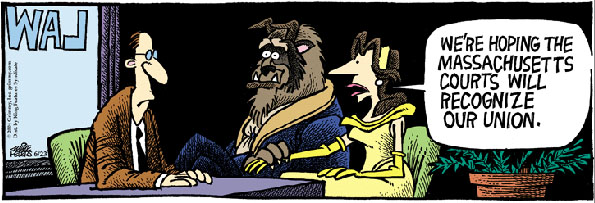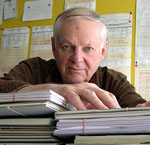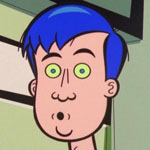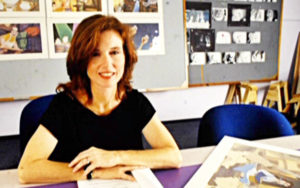 Linda Woolverton. From L.A. Life November 15, 1991, screenwriter Linda Woolverton said, “Adults will have something to chew on in Beauty and the Beast (1991). That’s why animated films are so interesting to make. You can put this great grown-up stuff in them. In my original draft, which was not a musical, we had enchanted objects but they didn’t have distinctive personalities and they didn’t speak. Howard (Ashman’s) idea was to make them sing and dance. We decided the objects were people – servants who had been enchanted into objects. That gave us a gold mine of characters.
Linda Woolverton. From L.A. Life November 15, 1991, screenwriter Linda Woolverton said, “Adults will have something to chew on in Beauty and the Beast (1991). That’s why animated films are so interesting to make. You can put this great grown-up stuff in them. In my original draft, which was not a musical, we had enchanted objects but they didn’t have distinctive personalities and they didn’t speak. Howard (Ashman’s) idea was to make them sing and dance. We decided the objects were people – servants who had been enchanted into objects. That gave us a gold mine of characters.
“I’ve always been a big fan of escapes. I realized that could be the turning point of the relationship. At that point she understands he’s not going to harm her in any way. They can commence to fall in love after that.
“Gaston was in my original non-musical draft but he was more of a dandy. She has many suitors in the fairy tale. I made them all one and then Howard (Ashman) turned him into this great character – a parody of a macho hunter. He’s a hunter, for one, so he’s the opposite of the beast. Then, in the end, as the beast gets more and more human, Gaston turns more and more into a monster. We had an ugly hero so we had to make his nemesis this handsome, full-of-himself hunter. There was a certain balance to it.
“I believed strongly in making Belle an independent, thinking, adventurous woman who wasn’t waiting for a man to give her a life. I thought that was an important thing to get across to the world. In the fairy tale, she was a lot more feminine – softer, I guess. My Belle has an edge. A lot of my personality went into her. I was not going to write a wimpy female character.
“I sometimes had to fight a little bit to make sure she mainted her strength. I was a watchdog to make sure she didn’t fall back into stereotypical behavior. I would say, ‘She doesn’t necessarily have to cry so much. Let her cry once or twice’. And they listend to me. I think she comes off pretty independent.
“The basic theme is ‘Love is letting go’. It’s about if you love something, you love it so much that you become secondary. The beast isn’t truly transformed until he lets her go. To me, that’s when he becomes a human being. His story is about finding you’ve changed and learning you were wrong.”

Mother Goose & Grimm. In the Daily News October 11th, 1991, Pulitzer Prize winning editorial cartoonist Mike Peters talked about the new 1991 Saturday morning cartoon series based on his popular comic strip Mother Goose & Grimm. “I’ve always wanted to do it,” said Peters who pioneered animated editorial cartoons with the “Peter Postscripts” for NBC Night News. He hated doing it. He hated the work, the trips to New York and the need to constantly feed the telecopier.
Besides working on the cartoon series, Peters continued to do five editorial cartoons a week plus six daily comics strip and a Sunday strip. “My second year doing the comic strip I thought, ‘I’m sorry but I’m out. It’s gone. It’s over. I’m a wasted scuzz’. And then I realized sometime during that year that I was the dog. I thought it would be more fun to do if the strip were autobiographical rather than doing single gags. That’s when I started story lines. That’s when it became exciting for me.”
 Richard Williams. From Stills magazine (U.K.) 1983, producer and animator Richard Williams said, “When Snow White was released in 1938 it was a terrific show. It had everything, and everyone went to see it. When something else does it again, it will have the same effect. If it’s a great show, everyone will go see it. That’s what we are trying to do with The Thief Who Never Gave Up.
Richard Williams. From Stills magazine (U.K.) 1983, producer and animator Richard Williams said, “When Snow White was released in 1938 it was a terrific show. It had everything, and everyone went to see it. When something else does it again, it will have the same effect. If it’s a great show, everyone will go see it. That’s what we are trying to do with The Thief Who Never Gave Up.
“I don’t think of animation as different from live action. What I’m trying to make is a terrific movie and my medium is animation. Most people say it’s the story that’s important. This is not true. It’s making the characters so that you forget that they are drawings. The only reason we have gone into such detail is to make it believeable.
“Believability – that is the key. Think about Dumbo (1941). You don’t think you’re watching drawings. That was Disney’s secret. Wait until you see the film. We’re going to change the face of animation.”
 The Downtowners. In 1998, it was announced that Warner Brothers was developing a new animated television series called The Downtowners created by Bill Oakley and Josh Weinstein that would debut fall 1999. Wallace Langham would voice the character Andy French, a twenty-five year old whose life is disrupted when his parents move to Wyoming and he’s forced to care for his younger brother voiced by Scott Menville. Both Langham and his character had blue hair.
The Downtowners. In 1998, it was announced that Warner Brothers was developing a new animated television series called The Downtowners created by Bill Oakley and Josh Weinstein that would debut fall 1999. Wallace Langham would voice the character Andy French, a twenty-five year old whose life is disrupted when his parents move to Wyoming and he’s forced to care for his younger brother voiced by Scott Menville. Both Langham and his character had blue hair.
The series was renamed Mission Hill because of MTV’s Downtown animated series that premiered at the same time and although 18 episodes were planned, only 13 were actually made. It was the first animated series to be developed by Castle Rock Entertainment’s Television unit.
Mission Hill received an award from GLAAD for its positive portrayal of a gay relationship.
Quints. In 1998, Meg Ryan’s Prufrock Pictures and actress writer Heather Thomas sold UPN a pilot presentation for an animated comedy about quintuplets in junior high. Quints was pitched as the female equivalent of South Park and “will deal with social, cultural and political issues relating to girls through humor”. It was pitched exclusively to UPN. Ryan was to lend her voice to the series.
Puff The Magic Dragon That Never Was. In 1998, Nelvana acquired the production, distribution and merchandise rights to Puff the Magic Dragon based on a folk song written by Peter Yarrow and Lenny Lipton. A thirty minute animated special produced by Murakami Wolf Swenson had been released in 1978 followed by Puff the Magic Dragon in the Land of Living Lies (1979) and Puff and The Incredible Mr. Nobody (1982).
Nelvana according to the Hollywood Reporter trade paper was simultaneously going to produce an animated feature film and a TV series to debut late in 1999. “One of Nelvana’s core competencies is adapting classic children’s characters and we think the song is a terrific vehicle,” said Michael Hirsh, co-CEO of Nelvana. “We have a lot of faith in the property. We think it has great appeal. It’s a song that kids know and love and it’s multigenerational.” It was also reported that Yarrow and Lipton would write new songs for both projects.



 Jim Korkis is an internationally respected animation historian who in recent years has devoted his attention to the many worlds of Disney. He was a columnist for a variety of animation magazines. With his former writing partner, John Cawley, he authored several animation related books including The Encyclopedia of Cartoon Superstars, How to Create Animation, Cartoon Confidential and Get Animated’s Animation Art Buyer’s Guide. He taught animation classes at the Disney Institute in Florida as well as instructing classes on acting and animation history for Disney Feature Animation: Florida.
Jim Korkis is an internationally respected animation historian who in recent years has devoted his attention to the many worlds of Disney. He was a columnist for a variety of animation magazines. With his former writing partner, John Cawley, he authored several animation related books including The Encyclopedia of Cartoon Superstars, How to Create Animation, Cartoon Confidential and Get Animated’s Animation Art Buyer’s Guide. He taught animation classes at the Disney Institute in Florida as well as instructing classes on acting and animation history for Disney Feature Animation: Florida.




















































Mission Hill was so great- still holds up watching it today! 🙂
I got to meet with Mike Peters at the Reuben Awards ceremony in Philadelphia last May. I asked him about the show, and he still has fond memories of it, considering it a positive experience.
The Seattle CBS affiliate (KIRO) hardly ever showed the Mother Goose and Grimm cartoon, replacing it with other things like news programs. I only got to see the show once.